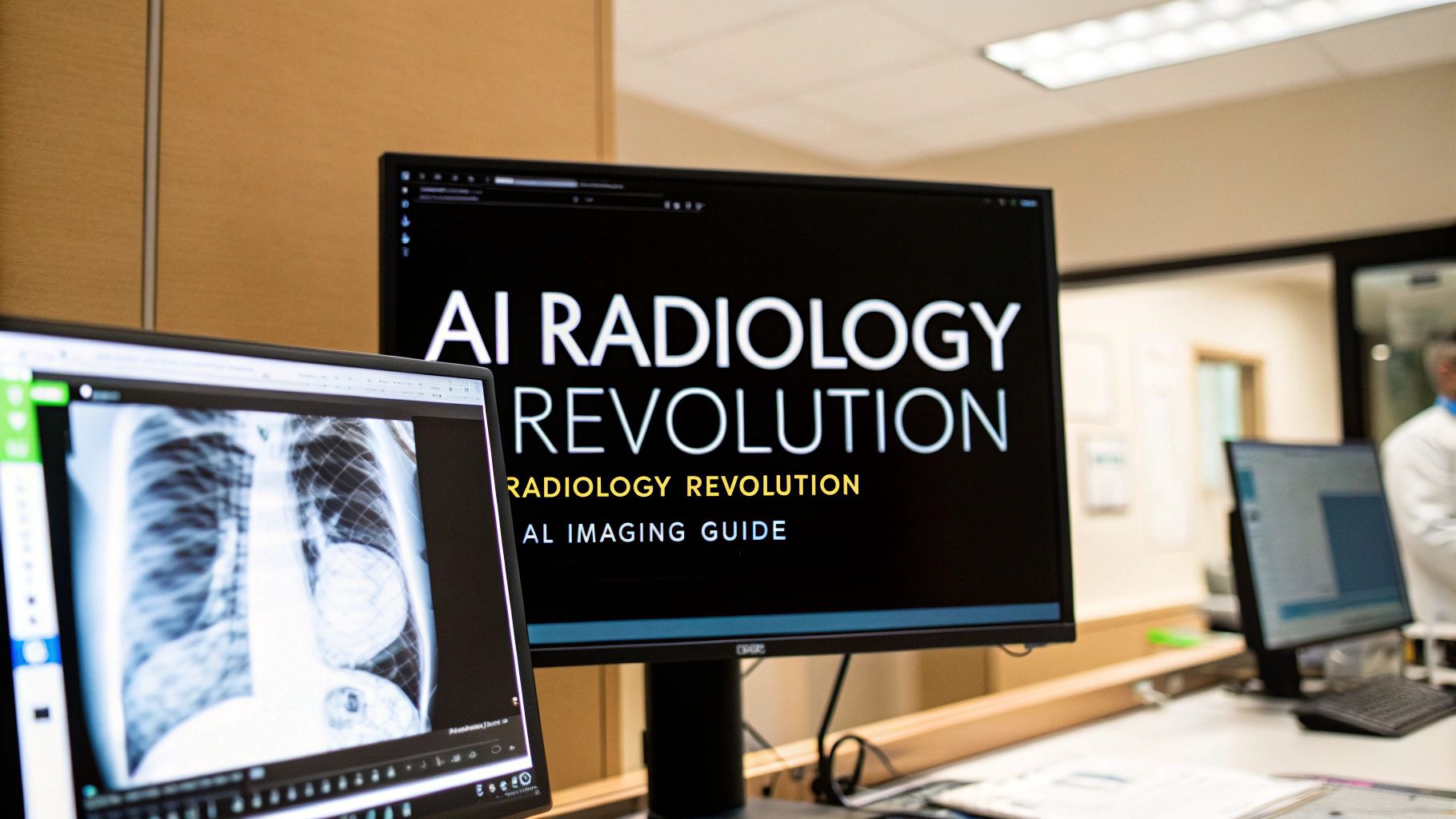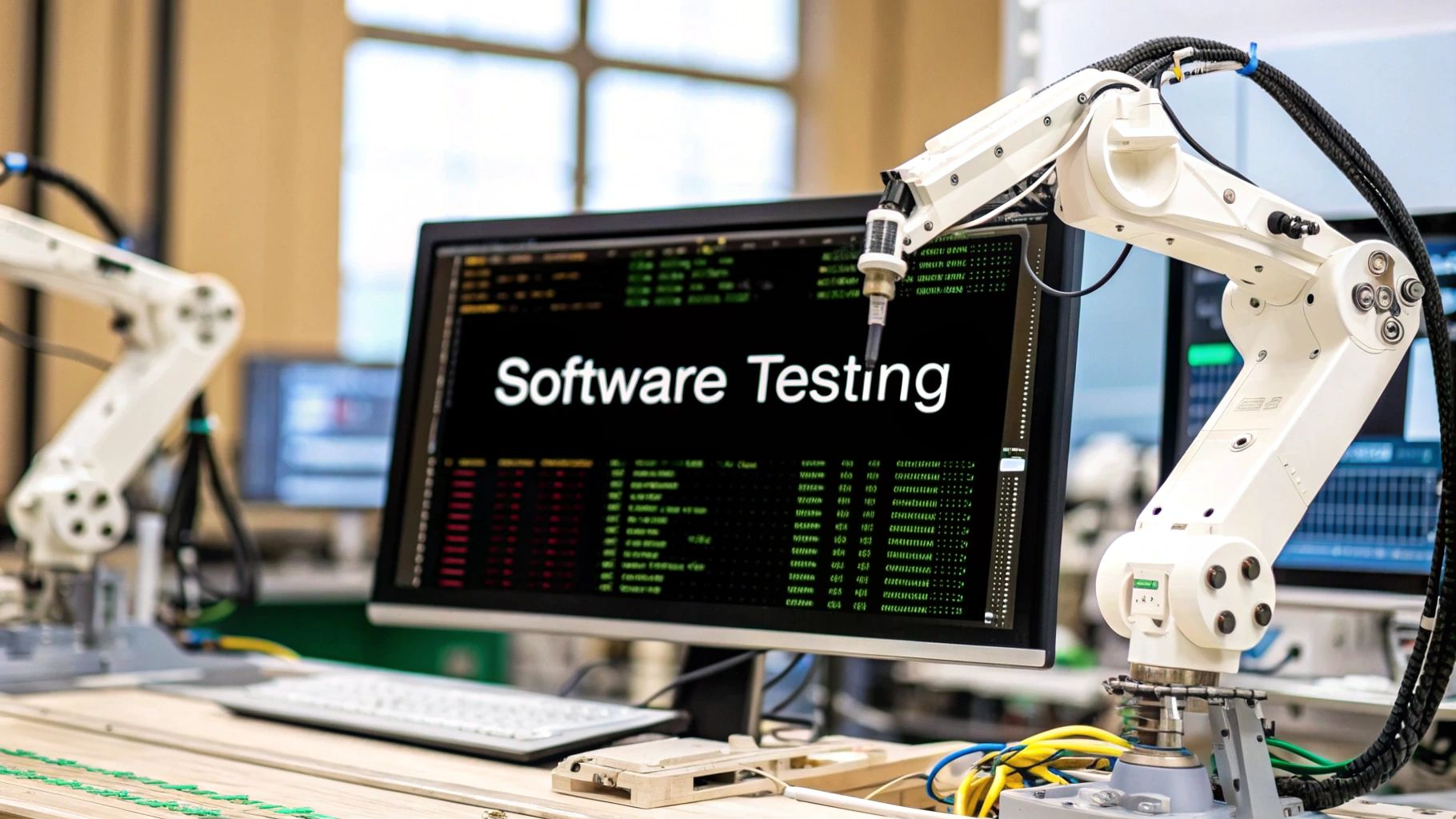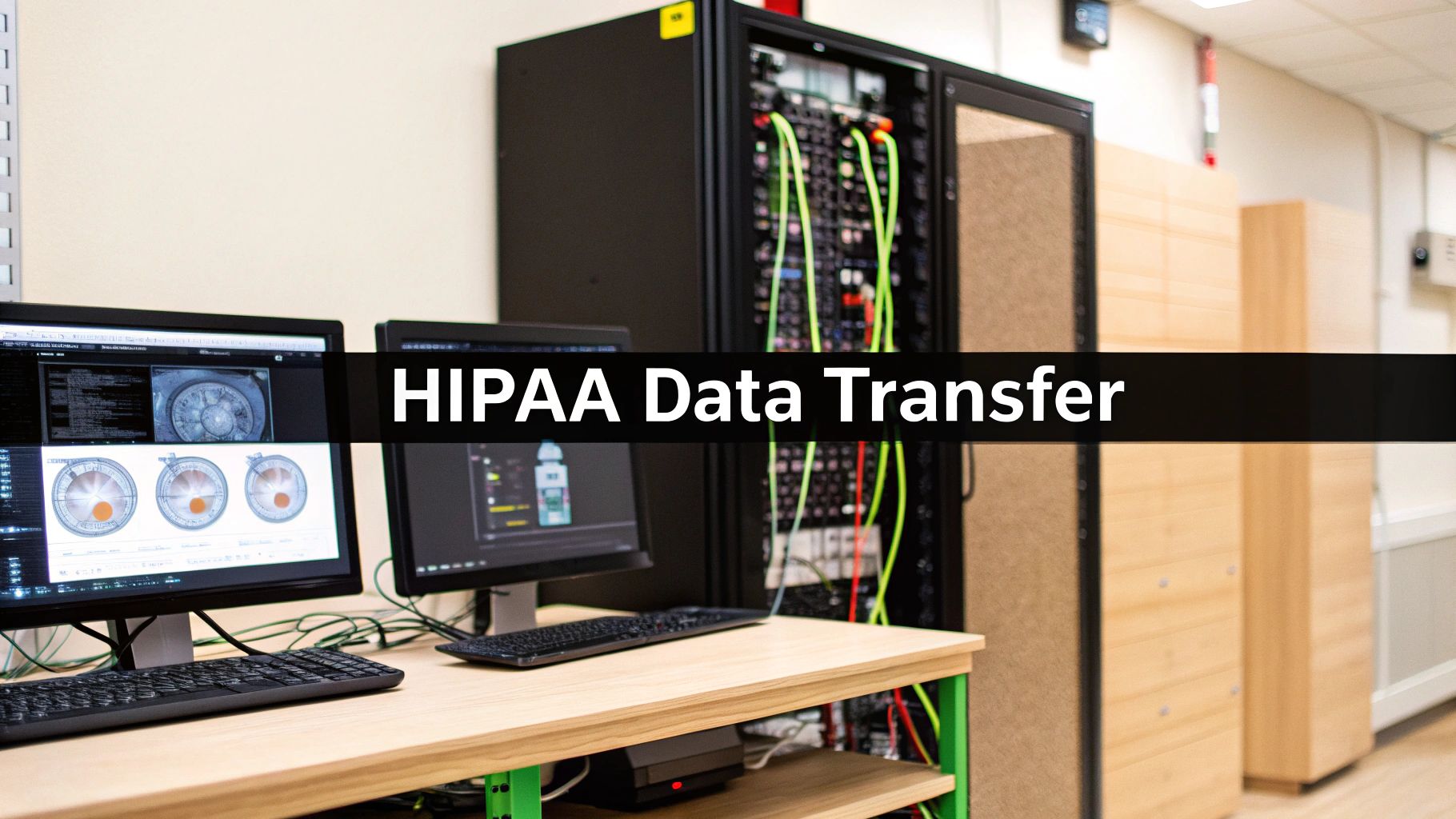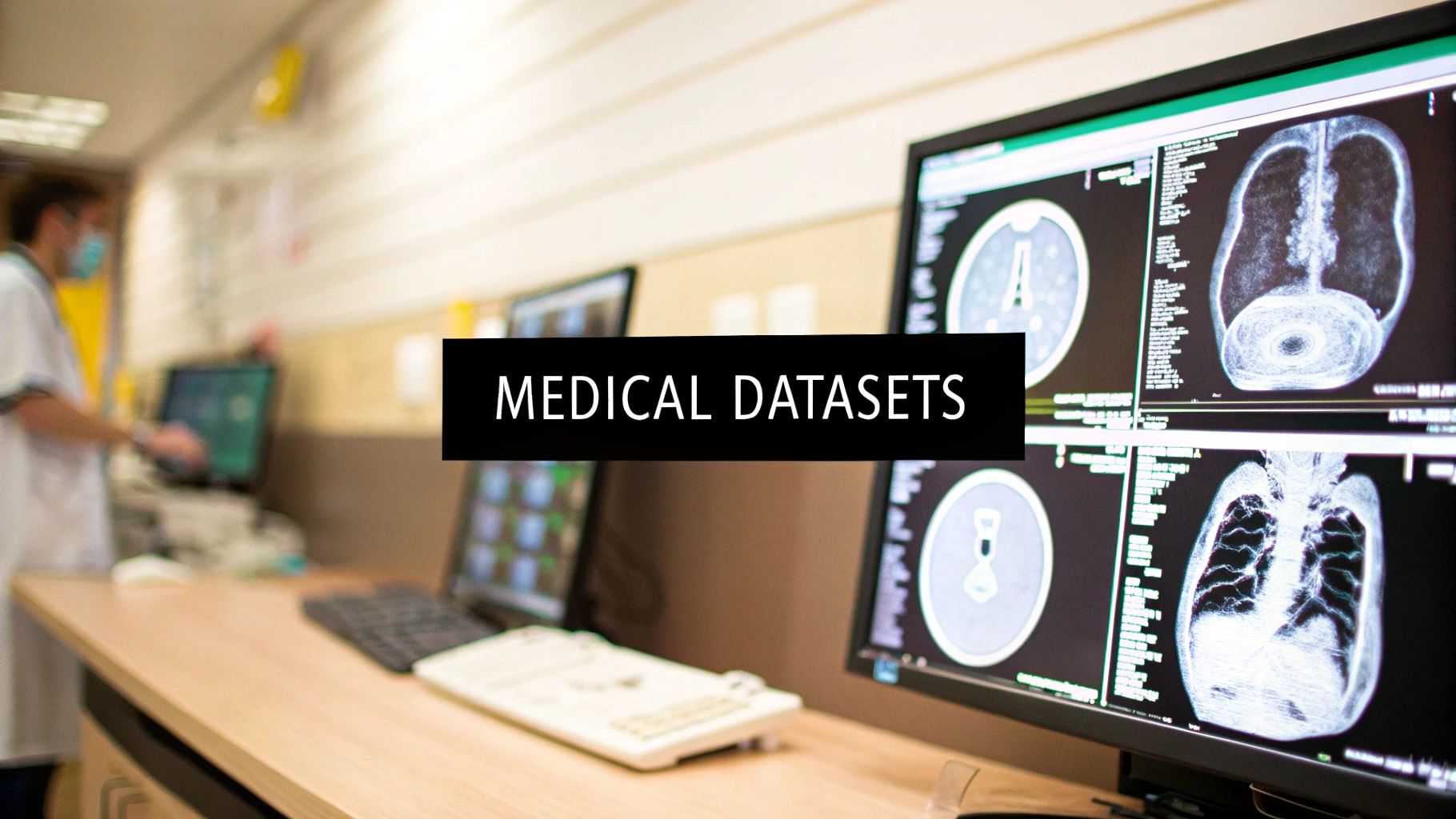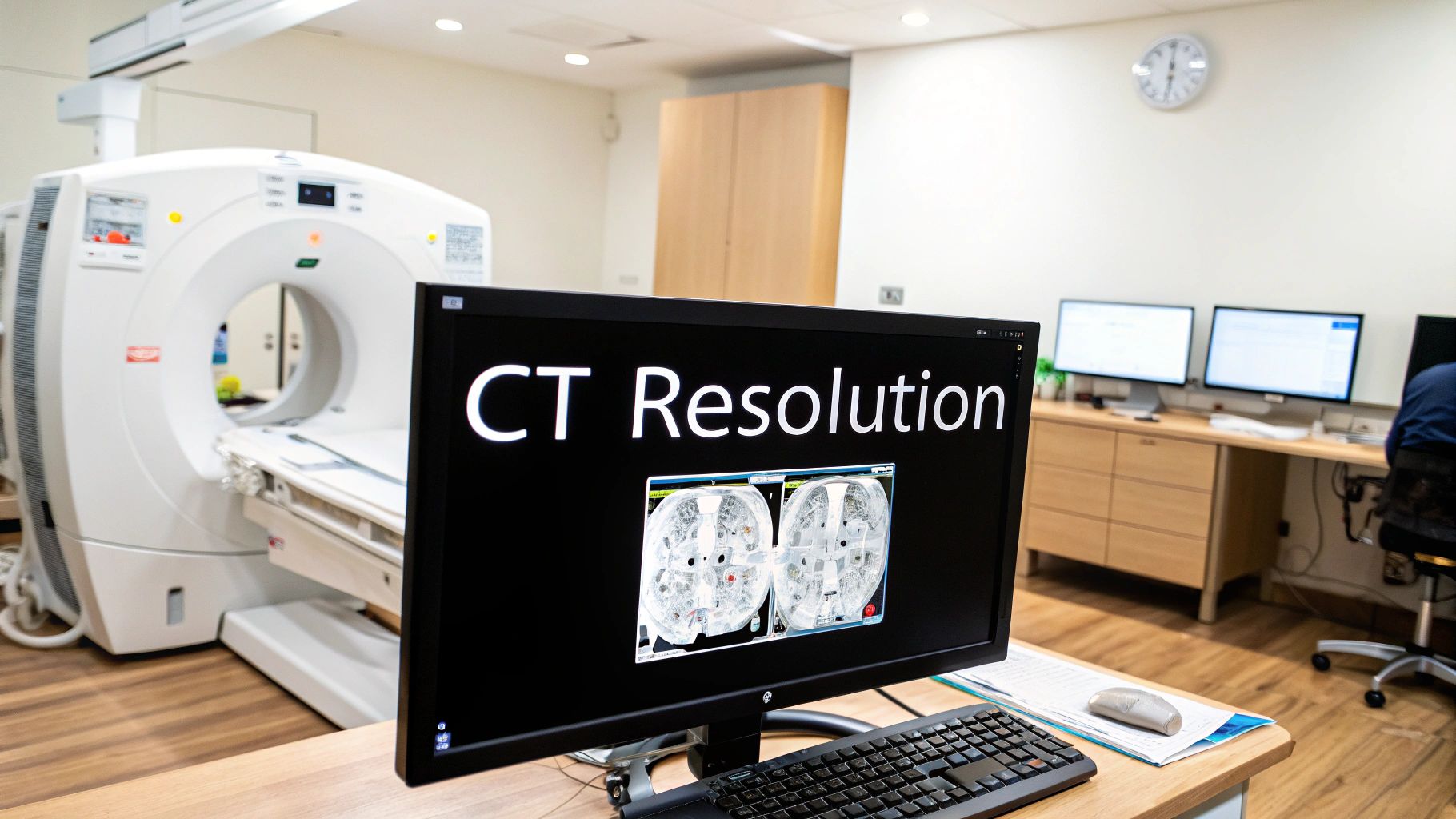Understanding How AI Is Reshaping Modern Radiology
Artificial intelligence (AI) is no longer a futuristic concept in the field of radiology. It's quickly becoming a core component of modern practice. This integration isn't about replacing radiologists; instead, it's about providing them with advanced tools to enhance their diagnostic abilities. Think of AI as a highly specialized assistant, capable of analyzing large volumes of data and identifying subtle patterns that a human eye might miss. This partnership between human expertise and AI is fundamental to the future of diagnostic imaging.
How AI Algorithms Analyze Medical Images
AI algorithms, especially those utilizing deep learning, are trained on extensive datasets of medical images. This training enables them to recognize and categorize various anatomical structures, pathologies, and anomalies. For instance, an AI algorithm can be trained to identify cancerous nodules in lung CT scans by studying thousands of examples of both healthy and cancerous lungs. The algorithm learns to differentiate subtle variations in image textures, shapes, and densities, ultimately helping radiologists make more precise and efficient diagnoses.
Key AI Applications in Radiology Today
Several AI applications are already having a significant impact on radiology. These include:
- Automated Image Analysis: AI can automatically measure organ volumes, detect fractures, and quantify blood flow. This automation frees radiologists from time-consuming manual tasks.
- Computer-Aided Detection (CAD): AI algorithms can highlight suspicious areas in images, prompting closer examination by a radiologist. This can lead to earlier diagnoses of diseases like cancer.
- Image Enhancement and Reconstruction: AI can improve image quality by minimizing noise and artifacts. This results in clearer images and more accurate interpretations.
These applications aren't just theoretical; they're actively being used in hospitals and clinics globally, improving patient care and streamlining radiology workflows.
The Growing AI in Radiology Market
The market for artificial intelligence in radiology is expanding rapidly. In 2024, this market was valued at approximately USD 2.2 billion. Projections for 2025 indicate a value of USD 2.86 billion, demonstrating a substantial CAGR of 30.2%. This growth is fueled by advancements in AI algorithms, increased integration with Electronic Health Records (EHR), and the increasing ability of AI to move beyond diagnosis into predictive analytics and personalized treatment plans. Learn more about this growing market here.
Why Radiology Departments Are Adopting AI
Progressive radiology departments are embracing AI for several key reasons. AI can help address the increasing radiologist shortage by automating routine tasks and boosting efficiency. It can also improve diagnostic accuracy and minimize errors, resulting in better patient outcomes. Furthermore, AI can contribute to more personalized treatment planning by providing detailed quantitative data about a patient's condition. This combination of factors makes AI a vital tool for improving the quality and effectiveness of modern radiology.
Game-Changing AI Applications Across Imaging Technologies
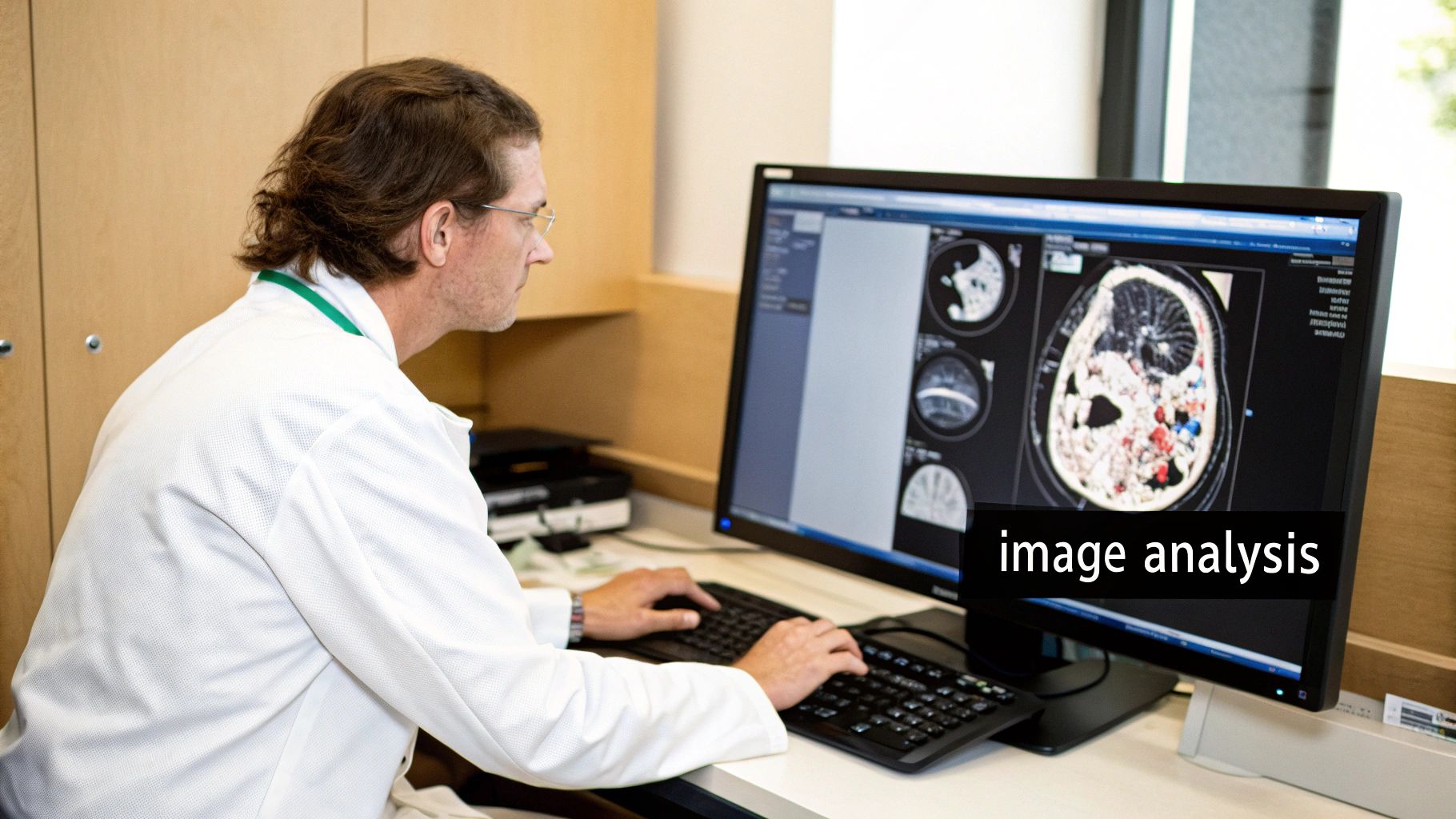
Artificial intelligence is rapidly changing the field of medical imaging, impacting everything from standard X-rays to complex MRI interpretations. This influence is particularly noticeable in areas where AI truly shines: early cancer detection, automated measurements, and complex pattern recognition. Let's explore how these AI applications are improving the speed and accuracy of diagnoses across various imaging modalities.
Early Cancer Detection With AI
AI's power to detect subtle anomalies often invisible to the human eye is revolutionizing early cancer detection. In mammography, for instance, AI algorithms can analyze images to find microcalcifications and other early signs of breast cancer, potentially leading to higher early detection rates and thus, earlier interventions and improved patient outcomes.
Similarly, in lung cancer screening, AI can analyze low-dose CT scans to identify small nodules that might be missed by radiologists using traditional methods. This early detection capability is essential for effective cancer treatment.
Automating Measurements and Eliminating Human Error
AI algorithms are exceptionally good at performing precise and consistent measurements of anatomical structures. In cardiac imaging, AI can accurately measure heart chamber volumes and ejection fractions, providing essential data for evaluating cardiac function.
This automation not only saves radiologists valuable time but also removes the possibility of human error, ensuring more reliable and consistent results. This level of precision is also highly advantageous in orthopedic imaging, where AI can accurately measure bone lengths, joint spaces, and angles, assisting in the diagnosis and ongoing monitoring of musculoskeletal issues.
Enhanced Pattern Recognition: Catching What the Human Eye Might Miss
While the human eye is remarkably adept at interpreting images, it can sometimes miss subtle patterns within complex medical scans. AI excels in recognizing these patterns. In neuroimaging, for example, AI can analyze MRI scans to find subtle changes in brain tissue linked to neurodegenerative diseases such as Alzheimer's.
These changes can be challenging for a radiologist to spot in the early stages, making AI a powerful tool for early diagnosis. This pattern recognition capability is particularly valuable in complicated cases or when working with extensive datasets.
The Growing Impact of AI in X-Ray Analysis
The application of AI in X-ray analysis can significantly decrease diagnosis times, a factor especially vital in time-sensitive emergency situations. AI algorithms can detect tiny patterns or abnormalities that might be overlooked by human radiologists, having a significant impact on patient outcomes.
The global AI in medical imaging market, estimated at USD 1.28 billion in 2024, is expected to reach approximately USD 14.46 billion by 2034. This demonstrates the increasing awareness of AI's potential. More specific data is available here: AI in Medical Imaging Market Size. For a broader understanding of the underlying technology, this resource provides an overview of the differences between AI, Machine Learning, Deep Learning. This rapid growth and investment clearly demonstrate the strong belief in AI's ability to transform the future of radiology.
Market Explosion And Investment Opportunities In AI Radiology
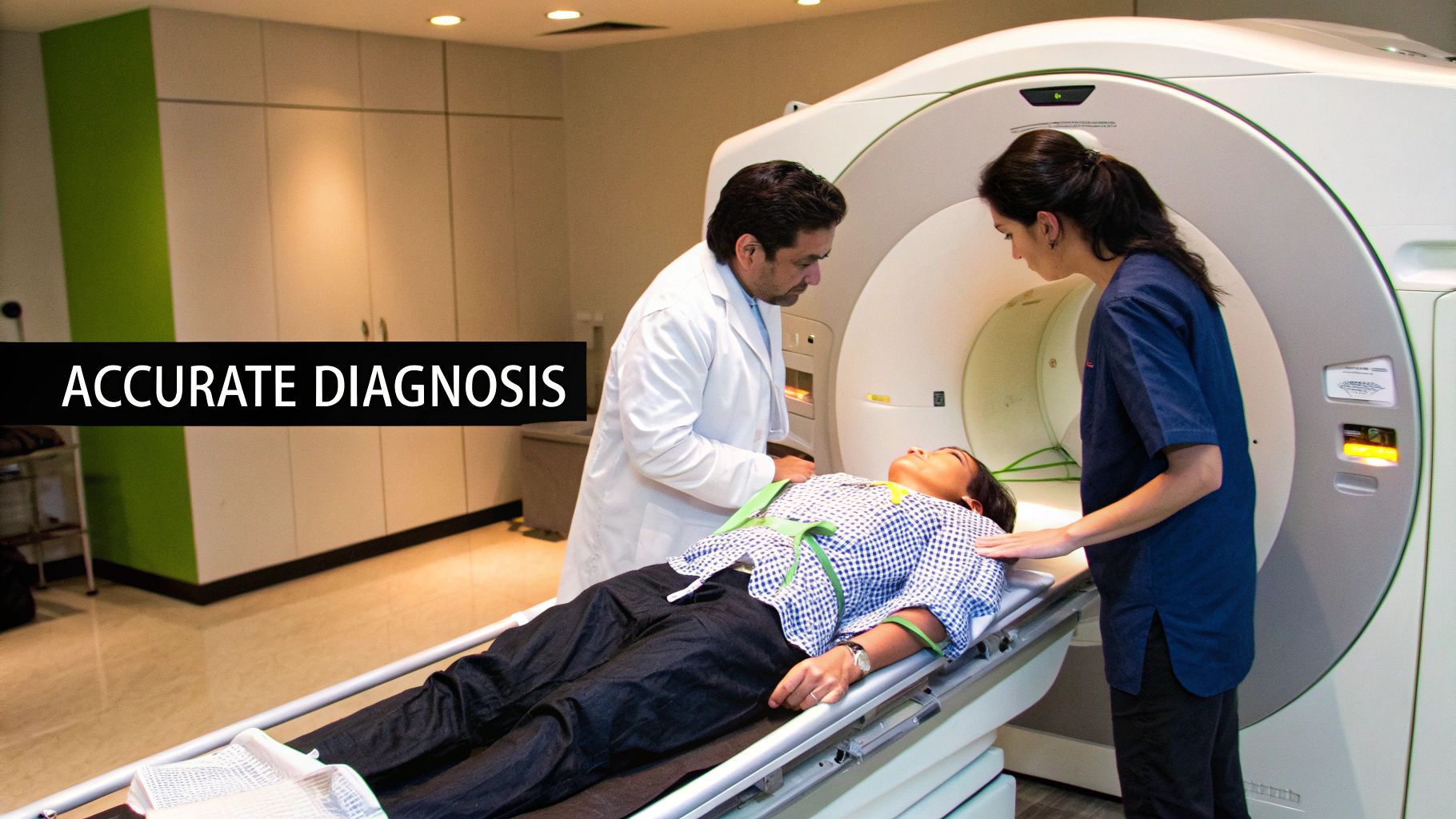
The field of artificial intelligence (AI) in radiology is experiencing rapid growth, attracting substantial investment. This reflects the increasing recognition of AI's potential to transform medical imaging and diagnostics. The current investment surge is fueled by real advancements and the promise of significantly improved patient care.
Understanding the Investment Landscape
Major players in healthcare, including established systems, large tech companies, and innovative startups, are actively investing in AI radiology solutions. These investments are targeting several key areas:
-
Algorithm Development: Funding focuses on creating more accurate and efficient AI algorithms for image analysis, disease detection, and personalized treatment planning.
-
Platform Integration: Investments aim to integrate AI tools seamlessly into existing radiology workflows and electronic health record (EHR) systems.
-
Data Acquisition and Management: Securing and managing large, high-quality datasets is critical for training effective AI algorithms, making this area another investment priority.
These strategic investments are reshaping the healthcare technology sector and accelerating the pace of innovation.
Market Segments Experiencing Rapid Growth
Specific segments within AI radiology are showing particularly strong growth. Some of the most notable include:
-
AI-Powered Diagnostic Tools: Tools that help radiologists achieve faster and more precise diagnoses are increasingly sought after.
-
AI-Driven Workflow Optimization Solutions: Solutions that automate routine tasks and streamline radiology workflows are gaining significant traction.
-
Predictive Analytics and Personalized Medicine: AI applications that can predict patient outcomes and personalize treatment plans are experiencing growing demand.
This targeted investment highlights the need for practical AI solutions that address real-world challenges faced by radiologists. The global AI in medical imaging market, including radiology, has shown substantial growth. Valued at USD 1.76 billion in 2023, it is projected to reach USD 23.65 billion by 2032, representing a CAGR of 33.48%. More detailed statistics can be found here.
Benefits for Healthcare Providers and Patients
The influx of investment brings concrete benefits for both providers and patients. AI can improve provider efficiency, reduce operational costs, and enhance diagnostic accuracy. For patients, this translates to earlier diagnoses, more personalized treatments, and improved overall outcomes. These clear advantages are driving further investment and encouraging wider adoption of AI in radiology.
Emerging Opportunities and Market Dynamics
Forward-thinking healthcare decision-makers are actively exploring opportunities in this evolving landscape. Key areas of focus include:
-
Strategic Partnerships: Collaborations among healthcare providers, technology companies, and research institutions are becoming increasingly common.
-
Early Adoption of Promising Technologies: Healthcare organizations are keen to adopt AI solutions with demonstrated clinical value.
-
Data-Driven Decision Making: Using data analytics to guide investment strategies and assess the impact of AI implementations is growing in importance.
Understanding these market dynamics enables healthcare leaders to strategically position themselves to capitalize on the transformative potential of AI in radiology. This includes selecting appropriate technologies and developing the necessary internal infrastructure and expertise.
Proven Benefits And Measurable Clinical Outcomes
Artificial intelligence (AI) in radiology isn't just a futuristic concept; it's actively improving clinical care. Hospitals and clinics implementing AI-powered radiology tools report significant improvements in diagnosis times, accuracy rates, and overall patient satisfaction. These benefits aren't just theoretical; they represent a real shift in how patient care is delivered.
Quantifiable Improvements in Radiology Practice
Integrating AI into radiology workflows has yielded substantial improvements in several key performance indicators:
-
Reduced Diagnosis Times: AI algorithms analyze medical images significantly faster than humans, accelerating diagnosis, especially in time-sensitive situations. This rapid turnaround is critical in emergencies, facilitating prompt intervention and potentially life-saving treatment.
-
Enhanced Accuracy Rates: AI algorithms excel at identifying subtle anomalies often missed by the human eye, thus boosting diagnostic accuracy. This improvement is crucial for patient outcomes, particularly in early disease detection, when interventions are most effective.
-
Improved Patient Satisfaction: Faster, more accurate diagnoses translate into more effective treatments and an overall better patient experience. When patients feel confident in their diagnosis and treatment plan, their satisfaction levels naturally rise.
These measurable improvements are fueling the widespread adoption of AI in radiology departments globally.
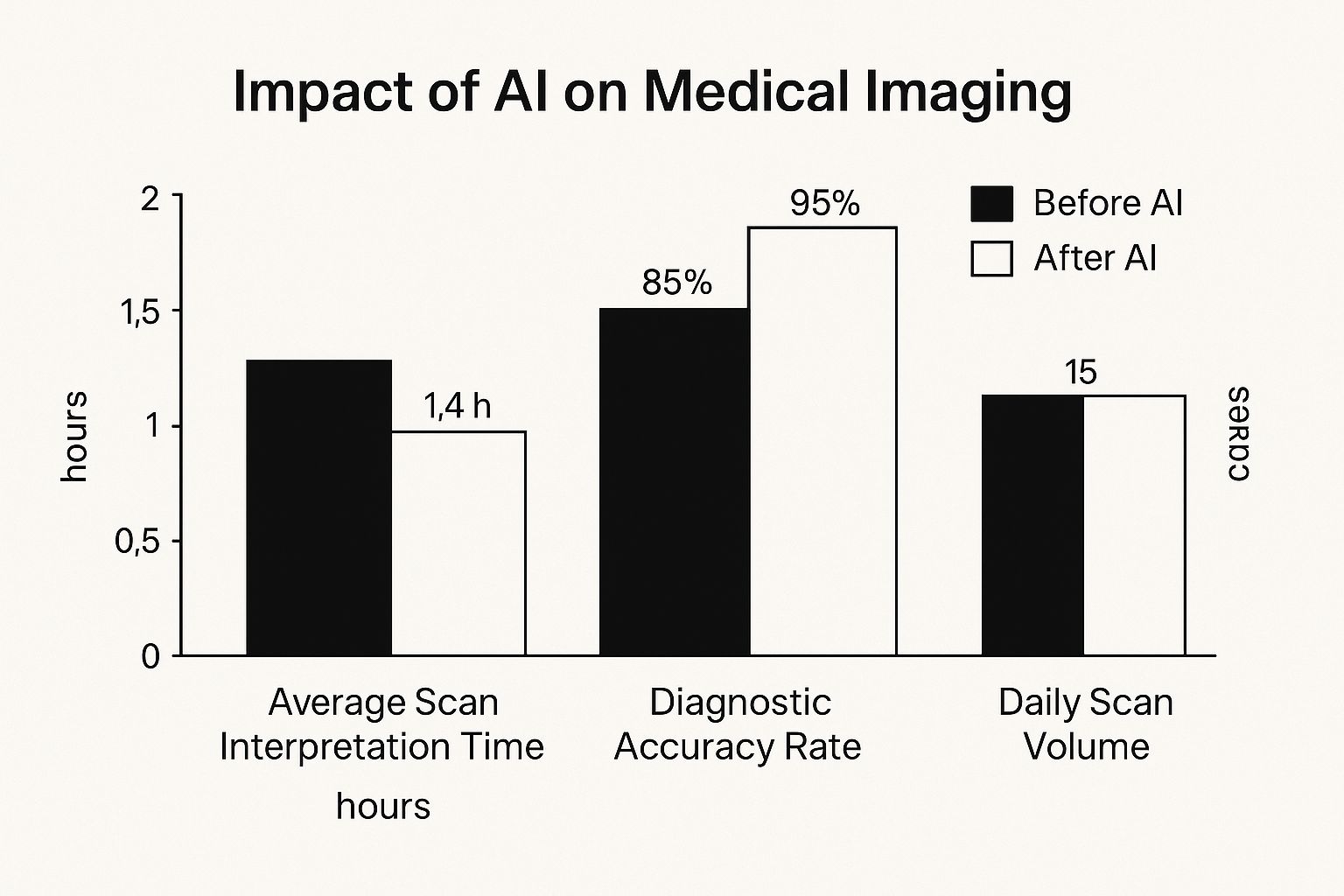
The infographic above visually represents the impact of AI on key radiology metrics: scan interpretation time, diagnostic accuracy, and daily scan volume. The data reveals a reduction in average scan interpretation time from 2 hours to 1.4 hours with AI implementation. Diagnostic accuracy increases from 85% to 95%, highlighting AI’s ability to enhance diagnostic precision. Daily scan volume increases from 10 to 15 cases per radiologist, illustrating the efficiency gains AI brings to radiology departments.
Let's take a closer look at these improvements in a table format:
AI Radiology Benefits Comparison: A comprehensive comparison of traditional radiology processes versus AI-enhanced workflows, showing improvements in speed, accuracy, and efficiency.
| Metric | Traditional Radiology | AI-Enhanced Radiology | Improvement |
|---|---|---|---|
| Scan Interpretation Time | 2 hours | 1.4 hours | 0.6 hours (30%) |
| Diagnostic Accuracy | 85% | 95% | 10% |
| Daily Scan Volume | 10 cases | 15 cases | 5 cases (50%) |
As shown in the table above, the use of AI tools in radiology demonstrates substantial gains across various metrics, suggesting significant potential for workflow optimization.
Addressing the Radiologist Shortage
AI in radiology offers a powerful tool to address the critical shortage of radiologists. By automating routine tasks like image analysis, AI frees up radiologists to focus on complex cases, validate AI findings, and dedicate more time to patient interaction. This improved efficiency not only boosts departmental productivity but also helps maintain a high standard of patient care despite workforce limitations.
Real-World Workflow Transformations
AI is transforming radiology workflows in practical ways. Some hospitals use AI for prioritizing urgent cases, ensuring that patients with the most critical needs are seen first. Other hospitals are using AI for pre-populating reports, saving radiologists valuable time and easing administrative burden. AI's influence is even being felt in seemingly unrelated industries. For instance, AI has started to impact sales strategies within the real estate sector, as detailed in this article: Sell More Properties With AI. These real-world examples highlight the ability of AI to improve the overall efficiency and effectiveness of radiology departments.
Cost Savings and Quality Improvements
The advantages of AI in radiology extend beyond workflow enhancements and increased efficiency. Improved diagnostic accuracy contributes to earlier disease detection, potentially preventing unnecessary procedures and resulting in cost savings for healthcare systems. This earlier and more precise diagnosis improves the quality of patient care. These combined cost savings and quality gains demonstrate the substantial value of AI in radiology, showcasing its potential not only for financial benefits but also for improved healthcare outcomes.
Overcoming Implementation Hurdles With Smart Solutions
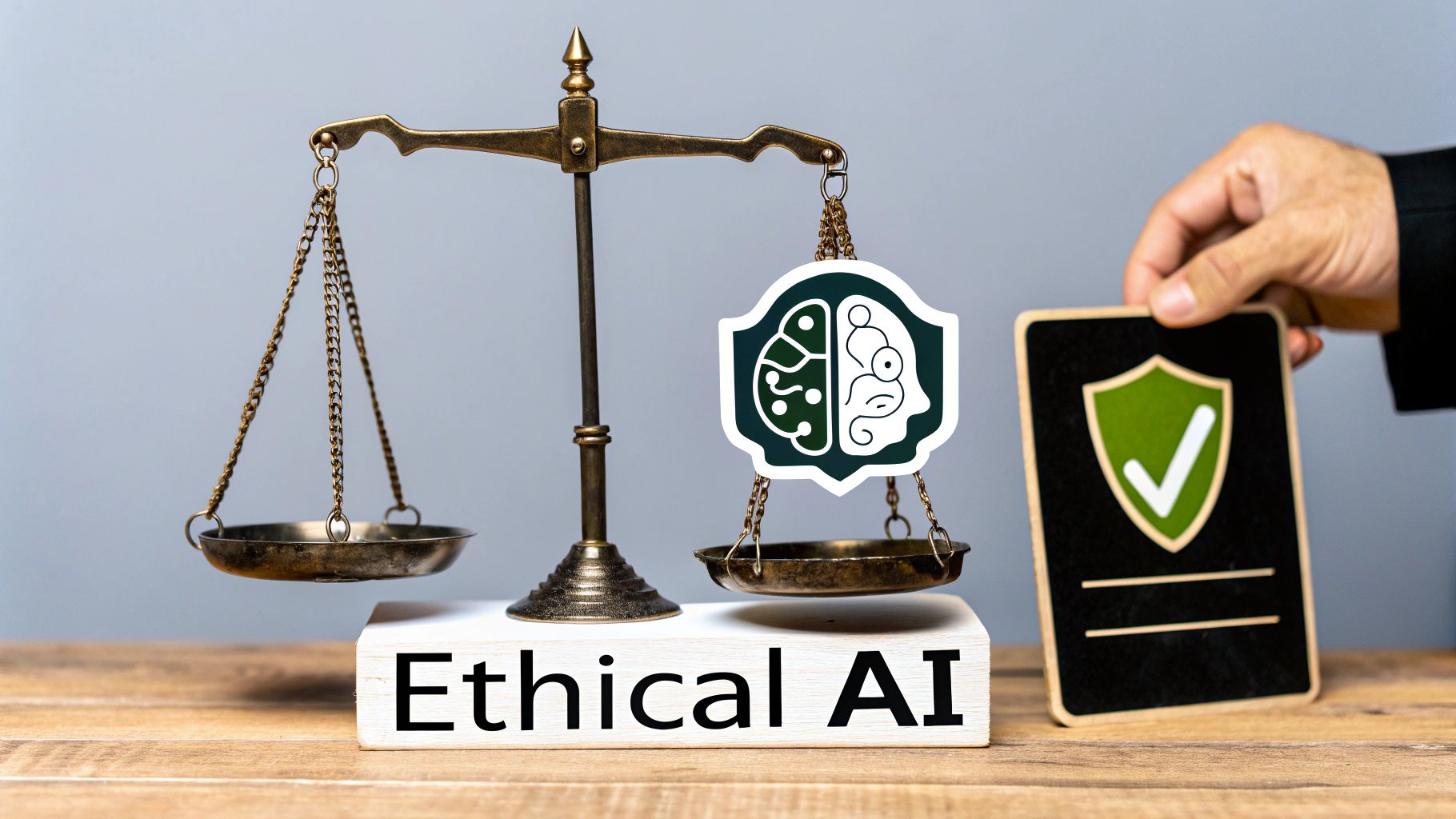
Integrating Artificial Intelligence (AI) into radiology workflows offers incredible potential, but it also comes with its fair share of challenges. Successfully incorporating AI requires careful planning, strategic decisions, and a practical approach to implementation. This section explores these challenges and offers actionable solutions for healthcare organizations.
Common Implementation Challenges
Several key obstacles often surface during AI implementation in radiology:
-
Complex Technical Integration: Integrating AI software with existing PACS and EHR systems can be technically complex, often requiring specialized IT expertise and meticulous coordination.
-
Staff Training Requirements: Radiologists, technicians, and other staff need comprehensive training to effectively utilize AI tools and accurately interpret the results generated by the AI.
-
Regulatory Compliance: Adhering to data privacy regulations like HIPAA and ensuring AI tools meet the required safety and performance standards are critical for responsible implementation.
-
Upfront Investment Costs: Implementing AI radiology solutions typically involves significant initial investments in software, hardware, and training programs.
These challenges, while substantial, can be effectively addressed with the right approach.
Strategies for Successful AI Deployment
Many hospitals and clinics have successfully integrated AI radiology solutions, offering valuable insights for other organizations:
-
Overcoming Resistance to Change: Successfully adopting AI hinges on effective change management. Clearly communicating the benefits of AI to staff, addressing their concerns, and providing thorough training are essential for fostering acceptance and encouraging active participation. Organizations with robust change management see 73% higher staff adoption rates and 56% faster time-to-value. Explore this topic further.
-
Ensuring Optimal Data Quality: AI algorithms depend on high-quality data for effective training and performance. Establishing clear data governance protocols, implementing rigorous quality checks, and maintaining data integrity are vital.
-
Managing the Transition Period: Transitioning to AI-driven workflows requires careful management to minimize disruptions. Phased implementations, pilot programs, and continuous performance monitoring can ensure a smoother transition and ongoing improvement.
These strategies can guide healthcare organizations through the complexities of AI implementation, significantly increasing the likelihood of success.
Practical Approaches and Best Practices
Several practical steps can enhance AI implementation:
-
Change Management: A comprehensive change management plan that addresses staff concerns, provides ample training, and fosters open communication is essential.
-
Vendor Selection: Carefully evaluate AI vendors, considering software functionality, integration capabilities, training support, and cost-effectiveness.
-
Building Organization-Wide Support: Securing support from key stakeholders, including radiologists, IT staff, and administrators, is crucial.
Realistic timelines, careful budget planning, and ongoing ROI assessment are also critical for successful implementation.
Measuring ROI and Demonstrating Value
Demonstrating a clear return on investment (ROI) for AI implementation is essential to justify continued support and future investments. Key metrics to track include:
-
Improved Diagnostic Accuracy: Measure the direct impact of AI on diagnostic accuracy.
-
Reduced Turnaround Times: Track the time saved in report generation through AI.
-
Increased Case Volume: Assess the contribution of AI to handling a higher daily caseload.
-
Cost Savings: Monitor reductions in operational costs associated with AI implementation.
By consistently tracking these metrics, organizations can showcase the tangible value of AI in radiology and secure continued support for further AI initiatives. This data-driven approach highlights the positive impact of AI on departmental efficiency and patient care.
Next-Generation AI Technologies Transforming Radiology
Artificial intelligence (AI) is evolving at a rapid pace, and radiology is poised to reap substantial rewards. Beyond the current uses, emerging AI technologies offer the potential to significantly improve diagnostic imaging, presenting new possibilities and changing how radiologists work.
Predictive Analytics: Anticipating Patient Needs
One exciting area of development is predictive analytics. AI algorithms are being designed to analyze patient information, including medical images, lab test results, and genetic data, to forecast the probability of developing specific conditions. For example, AI could estimate a patient's risk of developing lung cancer based on a combination of CT scan results and lifestyle factors. This ability to foresee potential health problems enables earlier intervention and has the potential to considerably improve patient outcomes.
This proactive approach can help healthcare providers make more informed decisions, leading to better treatment strategies and patient care. It empowers individuals to take control of their health and make proactive choices to mitigate future risks.
Personalized Treatment Strategies With AI
AI is also set to transform treatment planning. By analyzing individual patient information, AI algorithms can assist in designing customized treatment strategies. In radiation therapy, for example, AI could refine radiation dosage and targeting, maximizing the destruction of tumors while minimizing harm to surrounding healthy tissue. This targeted method can result in more effective treatments and fewer side effects.
This personalized approach moves away from a one-size-fits-all treatment model and allows healthcare professionals to tailor treatments to individual patient needs. This level of precision medicine has the potential to significantly improve treatment success rates and patient satisfaction.
Seamless Integration for Enhanced Efficiency
Next-generation AI aims for smooth integration within current healthcare technology systems. This means integrating AI tools with PACS (Picture Archiving and Communication Systems), EHR (Electronic Health Record) systems, and other clinical platforms. This interconnectivity improves workflows, simplifies data sharing, and fosters a more unified and efficient healthcare setting. It equips healthcare providers with readily available, comprehensive patient information, which enhances decision-making and improves care coordination.
This integrated approach breaks down data silos and facilitates better communication between different healthcare providers, leading to a more holistic and patient-centered approach to care.
Emerging AI Capabilities in Diagnostic Imaging
Several key advancements are propelling the evolution of AI in radiology:
-
Federated Learning: This method permits AI algorithms to be trained on information from various institutions without needing to directly share sensitive patient data. This collaborative learning approach speeds up AI development while safeguarding patient privacy.
-
Explainable AI (XAI): XAI systems offer insight into how AI algorithms reach their conclusions, increasing trust and transparency in AI-driven diagnoses. Understanding the logic behind AI's decisions boosts radiologists' confidence in using these tools and allows for improved validation of findings.
-
Real-Time Image Analysis: AI algorithms are being created to analyze images instantly, providing immediate feedback during procedures. This real-time capability is especially helpful in image-guided surgeries and interventions, supporting clinicians in making more accurate and informed decisions during procedures.
These innovations are expanding the possibilities of diagnostic imaging, offering new tools and techniques to improve patient care and outcomes.
The table below provides an overview of next-generation AI technologies being developed for radiology applications, including their potential impact and expected timeline for clinical adoption:
Emerging AI Technologies in Radiology
| Technology | Application | Development Stage | Expected Impact |
|---|---|---|---|
| Federated Learning | Training AI models on multi-institutional data without direct sharing | Clinical trials | Enhanced data privacy, improved algorithm performance |
| Explainable AI (XAI) | Providing insights into AI decision-making | Late-stage development | Increased trust and transparency, improved diagnostic confidence |
| Real-time Image Analysis | Analyzing medical images during procedures | Early clinical adoption | Improved guidance during interventions, faster diagnosis |
This table summarizes the key applications, development stages, and potential impacts of these emerging AI technologies. It highlights the active development of AI in radiology and its growing integration into clinical practice.
Moving From Research to Reality
Many of these next-generation AI technologies are progressing from research laboratories to clinical trials. This shift demonstrates the increasing maturity and potential of these advancements. As these technologies are refined and validated, they are anticipated to have a substantial influence on how radiology is practiced. Understanding these emerging trends will be vital for radiologists and healthcare institutions to adapt and excel in the future of medical imaging. For organizations interested in integrating advanced AI solutions into their medical imaging practices, PYCAD provides specialized knowledge and support. Discover how PYCAD can help transform your radiology department with AI.
